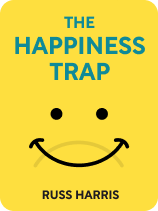

This article is an excerpt from the Shortform book guide to "The Happiness Trap" by Russ Harris. Shortform has the world's best summaries and analyses of books you should be reading.
Like this article? Sign up for a free trial here .
What is Acceptance and Commitment Therapy (ACT)? How can practicing ACT help you avoid falling into the “happiness trap”?
Acceptance and Commitment Therapy, or ACT, is a psychological discipline developed by Steven C. Hayes in 1982. Hayes developed ACT in the context of evolutionary psychology, which holds that our early survival instincts influence our modern brains—and that failing to recognize this connection undermines our happiness.
Here is how ACT can help you stop struggling and start living, according to Russ Harriss.
The Happiness Trap: Stop Struggling, Start Living
The Happiness Trap contends that humans are not wired to be naturally happy. On the contrary, the psychological mechanisms that helped our ancestors survive and reproduce make us uncomfortable (and unhappy) in the modern world.
Harris argues that fighting the natural inclinations of our brains in an effort to be happy all the time is a futile endeavor and only makes us more unhappy in the long term. Harris calls this paradox “the happiness trap.” He offers ACT as an empirically supported remedy to this universal problem of human experience.
The long-term goal of ACT is to help people develop “psychological flexibility,” a mindset that allows them to productively deal with their suffering and avoid the happiness trap. ACT seeks to promote psychological flexibility through six foundational principles:
- Connecting with the “observing self”: Your mind, or “self,” has two parts—your thinking self thinks, judges, and acts, while your observing self observes those actions. Activating your observing self can alter the way you deal with negative thoughts and feelings and how you connect to the world around you.
- Defusion: A mindfulness technique for acknowledging unwanted thoughts and images by relating to them through the observing self. (In general, mindfulness means focusing on the moment.)
- Expansion: A mindfulness technique for accepting uncomfortable feelings and urges by relying on the observing self to make space for them in your body.
- Connection: A mindfulness technique for becoming fully mentally present in your environment by prioritizing the nonjudgmental perceptions of the observing self.
- Clarifying values: A human being can’t live a meaningful life without values. ACT encourages you to discover the values that you hold dearest when you aren’t preoccupied by the constant quest to escape pain.
- Committed action: ACT defines two types of action essential to well-being. The first type is “effective action,” or action that corresponds with your values. The second type, which follows from the first, is “committed action,” which is effective action taken repeatedly without fear of consequence or failure.
- Committed action: ACT defines two types of action essential to well-being. The first type is “effective action,” or action that corresponds with your values. The second type, which follows from the first, is “committed action,” which is effective action taken repeatedly without fear of consequence or failure.
| Psychology of the Normal Steven C. Hayes, who developed ACT, has described the approach as “psychology of the normal.” Whereas other frameworks focus on detecting and correcting abnormal processes through diagnosing psychological disorders, ACT teaches people how to use normal brain functions in a productive way. For example, the abilities to analyze and evaluate are essential to our survival and ability to thrive—but, when these functions become overactive, they can send us into anxious spirals that actually inhibit our productivity and happiness. Hayes explains that since brain processes like analysis, evaluation, and problem-solving are necessary for everyday life, therapists can’t encourage people to stop them altogether, as they do with abnormal processes like obsessive compulsions. Instead, they must teach patients how to use these functions responsibly and productively. In this way, Hayes says that his purpose is not to “cure” or “fix” patients’ problems, but rather to give them the tools to overcome obstacles that naturally come up in life. |
ACT in Action: A Simple Choice
Harris writes that the ACT principles are not intended as a mandatory set of rules—rather, they’re intended to be applied practically. Use a technique when you think it will prove useful. In cases where you think another approach is more appropriate, do that instead.
That said, the principles of ACT are simple to apply to your life. Whenever you encounter a problem, you have two options in ACT:
- Apply your mindfulness skills to accept the problem. Practice defusion, expansion, and connection to connect with your observing self.
- Take action in accordance with your values to solve the problem. Often, you’ll do this after you’ve already used your mindfulness skills to connect with the situation.
This choice probably seems simplistic, but it takes the two elements that are directly under your control (your observing self and your actions) and harnesses them to deal with any problem you encounter. According to Harris, with this skill set, you can effectively move past the happiness trap.
| A Third Option for Dealing With Problems In The Power of Now, Eckhart Tolle identifies something similar to Harris’s two-option structure. While Harris argues that you must be present in order to accept a problem (option 1), Tolle asserts that you must be present in order to acknowledge the problem and pursue any options. In Tolle’s version of problem-solving, you have three options: 1) Change the situation (if you can). In other words, take effective action. 2) Leave the situation (if you can). In other words, take effective action. (This assumes that leaving the situation would be in alignment with your values.) 3) Accept the situation as it is. If you can’t change or leave the situation, you may be forced to accept it forever, or at least until things change and you can take another action. Although two of Tolle’s options could be considered effective actions—essentially making the list identical to Harris’s—there is value in distinguishing between the option of changing and leaving the situation. It can be easy to get so caught up in a problem that it feels that the only actions we can take must be within the context of that situation, but Tolle reminds us that leaving is often a viable option, too. |

———End of Preview———
Like what you just read? Read the rest of the world's best book summary and analysis of Russ Harris's "The Happiness Trap" at Shortform .
Here's what you'll find in our full The Happiness Trap summary :
- Why trying to be happy is making you unhappy
- How to practice ACT, or Acceptance and Commitment Therapy, to become happier
- How to develop “psychological flexibility” toward negative feelings instead of eliminating them






